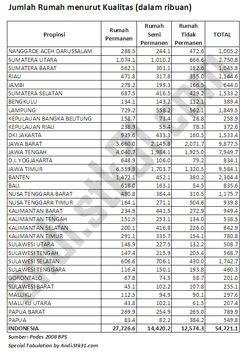Permanent house are houses whose walls were made of the wall / wood (high quality), the floors made of tile / ceramic / high quality wood and its roof made of zinc / tiles / shingles / asbestos.
Semi-permanent house was the home whose walls a half wall / brick without plaster / wood (low quality), floor tile / cement / low-quality wood and corrugated iron roof / roof tile / shingle / asbestos.
The house is not permanent is the house whose walls are simple (bamboo / board / leaf), from the ground floor, and roof of leaves or a mixture of roof tile / zinc used and the like.
 Based on calculations, in the year 2008 there were approximately 54.7 million houses in Indonesia (not including commercial, Rukan, beds, & other buildings rather than as a residence). The majority (50%) is the permanent house and about 23% houses are not permanent. Approximately 58.6% houses located on the island of Java, where Java, East Java, West and has the largest number of houses, close to 10 million house. As for Babel, Gorontalo, West Sulawesi, Maluku and North Maluku has a number of houses less than 300 thousand houses.
Based on calculations, in the year 2008 there were approximately 54.7 million houses in Indonesia (not including commercial, Rukan, beds, & other buildings rather than as a residence). The majority (50%) is the permanent house and about 23% houses are not permanent. Approximately 58.6% houses located on the island of Java, where Java, East Java, West and has the largest number of houses, close to 10 million house. As for Babel, Gorontalo, West Sulawesi, Maluku and North Maluku has a number of houses less than 300 thousand houses.The number of these houses may be a measure of poverty in terms of housing, but the form of a houses in Indonesia is strongly influenced local culture and environment (forests, swamps, mountains and weather).